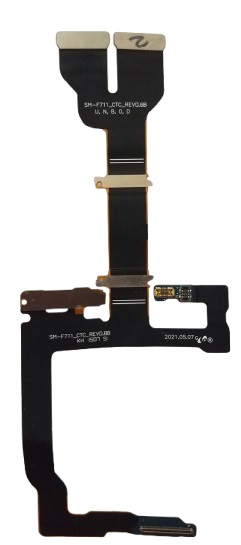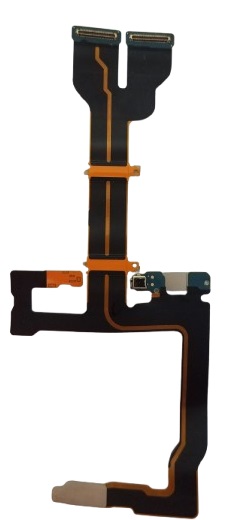
The LCD flex cable, or flex for short, is a crucial component in the Samsung Z Flip 2, or any other smartphone, that facilitates the connection between the various internal parts of the phone, especially the display and the motherboard. In this case, it serves as the link between the flexible OLED screen and the phone’s internal circuitry.
Here’s a detailed explanation of the LCD flex cable/flex for the Samsung Z Flip 2
1. Function of the LCD Flex Cable
- The primary role of the LCD flex cable is to carry electrical signals between the display (LCD or OLED) and the phone’s main board (motherboard). These signals control the screen’s functionality, such as touch input, display output, color reproduction, brightness, and more.
- The flex cable also includes connectors for other functions, such as powering the display, transmitting data from the touchscreen, and enabling other interactive features like sensors or proximity detection.
2. Design and Structure
- The flex cable itself is made from a highly flexible material, typically a thin strip of flexible printed circuit (FPC) or polyimide (PI) that is designed to withstand bending, folding, and twisting.
- For the Samsung Z Flip 2, the flex cable is specially designed to accommodate the phone’s unique folding form factor. The Z Flip 2’s display needs to fold seamlessly without damaging the internal components. Hence, the flex cable is engineered to bend and adapt to the folding mechanism of the phone.
- The cable often includes multiple layers of microelectronic connections, ensuring that power, data, and signals are transmitted effectively.

3. Specific Role in Samsung Z Flip 2
- Foldable Display Technology: The Samsung Z Flip 2 utilizes a foldable OLED screen. Unlike traditional smartphones, foldable displays are designed to flex and bend multiple times, which presents challenges in how the display’s electronics (including the flex cable) are designed.
- The flex cable in the Z Flip 2 allows for a tight, secure connection that doesn’t interfere with the foldable mechanism while ensuring the smooth performance of the flexible display.
- Connection to the motherboard: The flex cable in the Z Flip 2 connects the display to the phone’s mainboard, ensuring the transfer of power and data to the OLED panel. It ensures that the touchscreen works properly and that images and video are displayed correctly.
4. Technical Aspects
- Electrical Conductivity: The flex cable is designed to have excellent electrical conductivity to transmit signals and power with minimal loss. Fine traces of conductive material like copper are used in the cable to allow for the fast and efficient transmission of data.
- Bending Capacity: As the Z Flip 2 is a foldable phone, the flex cable is designed to bend repeatedly without degrading. This is important to ensure that the phone functions properly over time, especially as the display folds and unfolds.
- Multiple Connections: The flex cable usually features several connectors or micro connectors to interface with the internal circuitry of the phone. These connectors allow the display to work with different systems like touch input sensors, the screen backlight, or image processing chips.
5. Durability and Material Choices
- The material used in the flex cable is designed to withstand repeated use. In the case of the Samsung Z Flip 2, the flex cable is engineered for durability, considering the phone’s folding nature.
- Polyimide (PI): The base material for many flex cables is polyimide, a flexible, heat-resistant polymer known for its reliability under stress. This makes the cable resistant to heat, bending, and general wear and tear.
- Shielding: Some flex cables are shielded to protect the data signals from electromagnetic interference (EMI), which can cause issues like screen flickering, poor touch sensitivity, or image distortion.
6. Replacement and Repair Considerations
- Fragility: While designed for flexibility, the flex cable is still delicate. In the event of damage, such as from wear and tear or an accident, it can affect the functionality of the screen or the entire phone. Replacement is often complex and can require professional servicing, as it involves dismantling parts of the device.
- Cost: Replacing a flex cable on a foldable device like the Samsung Z Flip 2 can be expensive, as the cable is intricate and integral to the operation of the foldable display. This repair should typically be performed by a technician with experience working on foldable phones.
7. Common Issues and Symptoms
- Display Malfunctions: If the flex cable becomes damaged, it could cause issues like a blank screen, unresponsive touch input, or distorted display. You might notice flickering or partial loss of image on the screen.
- Screen Flexing Problems: Since the phone is foldable, any issue with the flex cable could result in an improper folding experience, where the screen doesn’t fold correctly or shows visible defects when the phone is in the folded state.
- Touchscreen Sensitivity: Any issue with the flex cable can lead to unresponsiveness or delayed touch input, which can make it difficult to use the phone effectively.
8. Why Flex Cables are Important for Foldable Phones
- Complexity of Foldable Displays: Foldable phones require highly specialized components to function smoothly, and the flex cable is one of the most important parts of this puzzle. Its ability to bend without losing signal integrity is essential for the foldable form factor to work efficiently.
- Minimizing Wear and Tear: The flex cable’s flexibility allows it to endure the repeated folding and unfolding that the Z Flip 2 undergoes without significant degradation, unlike rigid connectors found in non-folding smartphones.
9. Conclusion
The LCD flex cable for the Samsung Z Flip 2 is an essential component for ensuring the proper functioning of the foldable display. Its design, materials, and flexibility are key to supporting the Z Flip 2’s unique foldable form factor. Without a properly functioning flex cable, the display would fail to perform optimally, leading to issues with touch response, display quality, or even complete failure of the screen.
Given the critical nature of this component, if your Z Flip 2 experiences display issues or screen malfunctions, the flex cable might be the cause, and it’s best to seek professional repair or replacement.